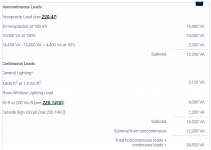Psychlo
Member
- Location
- Melissa, TX
- Occupation
- Master Electrician
So I read through a post from '22 that is now closed which discussed this issue. And I question the conclusions drawn there. It seemed to be a consensus that continuous loads were not to be considered for a load calc - only for conductor and OCPD sizing. That sounds right at first....
But what about Table 220.12 [T220.42(A) in 2023]? We are specifically told in the table note that 125% was figured into the minimum lighting load values in the table, due to their continuous nature. It even refers to 210.20(A) as backup.
The STRONG implication is that any lighting load that is on for 3 or more hours at a time requires the extra 25% to be added for the calculation.
This would mean that show window lighting, track lighting, and sign & outline lighting, would require the extra 25% as well.
This could make a big difference on an license exam for someone.
I would appreciate your thoughts.
But what about Table 220.12 [T220.42(A) in 2023]? We are specifically told in the table note that 125% was figured into the minimum lighting load values in the table, due to their continuous nature. It even refers to 210.20(A) as backup.
The STRONG implication is that any lighting load that is on for 3 or more hours at a time requires the extra 25% to be added for the calculation.
This would mean that show window lighting, track lighting, and sign & outline lighting, would require the extra 25% as well.
This could make a big difference on an license exam for someone.
I would appreciate your thoughts.


